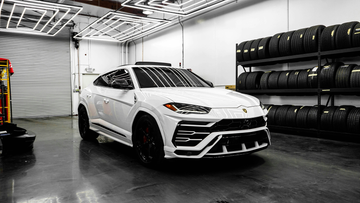What Should My Tire Pressure Be & How Often Should I Check It?
Why Tire Pressure Matters
Proper tire pressure is one of the simplest — yet most overlooked — aspects of car maintenance. Driving with underinflated tires reduces fuel efficiency, increases wear, and makes handling less stable on wet or icy roads. Overinflation, on the other hand, causes a harsher ride and uneven tread wear.
Keeping your tires properly inflated ensures better grip, longer lifespan, and safer driving — especially during seasonal changes when temperatures affect PSI levels dramatically.
What Should My Tire Pressure Be?
Most vehicles require a tire pressure between 30–35 PSI (pounds per square inch), but it’s always best to follow your manufacturer’s recommendation.
You can find the correct PSI listed:
-
On a sticker inside the driver’s door jamb
-
In your owner’s manual
-
Or on the fuel door
Always check tire pressure when the tires are cold, ideally before driving or after the car has been parked for several hours. This gives the most accurate reading since driving warms the tires and raises internal air pressure.
How Often Should You Check Tire Pressure?
For most drivers, checking tire pressure at least once a month is a smart habit. However, tire pressure isn’t a “set it and forget it” number — it fluctuates with temperature changes, road conditions, and driving habits. Understanding how weather affects your tires helps you stay safer and extend their lifespan year-round.
Tire Pressure in Cold Weather
In winter, your tires lose air faster than you might think. On average, pressure drops about 1 PSI for every 10°F decrease in temperature, which means a chilly morning can make perfectly filled tires appear underinflated. Underinflated tires reduce traction on snow and ice, increase braking distance, and wear unevenly — all of which can compromise safety.
That’s why during colder months, it’s best to check your tire pressure every two weeks, or anytime the temperature swings drastically overnight.
Tire Pressure in Warm Weather
In summer, heat causes the air inside your tires to expand, raising PSI levels. Overinflated tires can lead to a rougher ride and reduced contact with the road, especially during long highway drives. Check your tire pressure regularly on hot days, especially before long trips, to prevent uneven wear or blowouts.
All-Season Pressure Care
Whether it’s cold winter mornings or scorching summer afternoons, maintaining consistent tire pressure is essential. Always check your PSI when your tires are cold (before driving), and adjust according to your manufacturer’s recommendation — not the number on the tire sidewall.
Regular checks prevent small leaks or seasonal shifts from turning into dangerous underinflation issues. Using a digital tire gauge or a wireless monitoring system like SolarTire Alert™ can help you track changes in real time and maintain perfect balance through every season.
Best Tools for Tire Maintenance
Monitor Tire Health with SolarTire Alert™
Stay informed and protected with the SolarTire Alert™ | Wireless Tire Pressure Monitoring System — the smarter way to keep your tires in check. Powered by solar energy, it provides real-time tire pressure and temperature readings right on your dashboard. Its wireless sensors detect slow leaks and sudden drops instantly, helping you prevent blowouts and extend tire life. Easy to install and maintenance-free, SolarTire Alert™ ensures safer, more fuel-efficient driving all year long.
Handle the Unexpected with AirPumpMax 150™
A flat tire in freezing weather doesn’t have to ruin your trip. The AirPumpMax 150™ | 4x High-Performance Cordless Air Pump ensures you’re never left waiting for roadside assistance when temperatures drop. Compact, fast, and completely cordless, it delivers powerful inflation anywhere — no cables, no stress. In minutes, it restores traction and stability, helping you get safely back on the road. Its digital pressure gauge and automatic shut-off ensure precise inflation every time. Pair it with a tire repair kit for complete peace of mind on every winter drive.
Stay Safe — and Stylish — with LumiWheel™
Who says safety can’t turn heads? The LumiWheel™ | Illuminated Safety Tire Valve Caps bring together visibility, protection, and modern design in one sleek upgrade. These motion-activated LED valve caps light up your wheels as you drive, improving visibility at night and in foggy or snowy conditions while adding a bold, eye-catching glow to your ride. Beyond style, they act as an extra layer of valve protection — helping prevent slow leaks and dirt buildup after you’ve checked and adjusted your tire pressure. With LumiWheel™, you’re not just staying safe — you’re driving in style.
Final Thoughts
Keeping your tires properly inflated is one of the easiest and most effective ways to protect your vehicle, improve performance, and stay safe on the road. Temperature changes can have a major impact on PSI, but regular checks — paired with smart tools like portable inflators and monitoring systems — help you stay one step ahead of the elements.
Before your next drive, take a few minutes to check your tire pressure, especially when the seasons change. It’s a small habit that delivers big benefits — for your safety, your savings, and your peace of mind.





